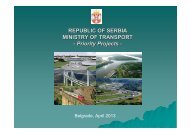Innovation Canada: A Call to Action
Innovation Canada: A Call to Action
Innovation Canada: A Call to Action
Create successful ePaper yourself
Turn your PDF publications into a flip-book with our unique Google optimized e-Paper software.
<strong>Innovation</strong> <strong>Canada</strong>: A <strong>Call</strong> <strong>to</strong> <strong>Action</strong>rate for the program increases beyond a certainthreshold. Some level of subsidy is of courseneeded <strong>to</strong> stimulate the behaviour that aprogram is trying <strong>to</strong> encourage. But anincreasing subsidy obviously raises the “cost”side of the equation directly and also steadilyincreases the likelihood that projects withpoorer expected returns will be undertaken, orthat businesses with poor prospects will besustained longer than they otherwise would be.Either of these outcomes reduces the addedbenefit contribution of the program. At somepoint, the additional cost of a higher subsidywill exceed the additional social benefit thatmore generously subsidized projects induce.Were this <strong>to</strong> occur, the subsidy rate should bereduced. When subsidies associated with severaldifferent programs are combined <strong>to</strong> support agiven project, the risk of excessive subsidizationobviously increases. This is why it is important <strong>to</strong>take an overall portfolio approach <strong>to</strong> a suite ofR&D programs and <strong>to</strong> establish closecooperation between federal and provincialgovernments in this regard.As noted in Chapter 5, the SR&ED program isboth lauded and criticized. In the latter regard,its complexity results in excessive compliancecosts, unpredictability about qualification andfirms having <strong>to</strong> resort <strong>to</strong> retaining consultants,the cost of which diminishes the benefit.Compliance costs are currently estimated <strong>to</strong> beapproximately 14 percent of the value of creditsearned by small firms and 5 percent for largefirms. 3 At the same time, the program’senhanced benefit for small firms may be richerthan necessary, particularly given thecompounded effect of provincial credits andother government support programs. Figure 6.4shows the impact of combining the R&D taxcredits provided by individual provinces withfederal SR&ED credits. Box 6.3 providesaFigure 6.4 Federal and Provincial Tax Credit Rates (%)Provinces Provincial Tax Credit Federal Plus Provincial aCCPCsOther FirmsAlberta andBritish Columbia 10 42 28Mani<strong>to</strong>ba 20 48 36New Brunswick,Newfoundland andLabrador, Nova Scotia,Saskatchewan andYukon 15 45 32Northwest Terri<strong>to</strong>riesand Prince Edward Island 0 35 20Ontario (small/large firms) 10/4.5 42 24Quebec (small/large firms) b 37.5/17.5 48 27The federal credit is 35 percent for small CCPCs and 20 percent for other firms. The base for the federal credit is reducedby the amount of provincial credits.b The Quebec credit is paid on wages and salaries plus 50 percent of contracts. The federal–provincial rate is expressed as apercentage of R&D costs eligible for the SR&ED credit.Source: PricewaterhouseCoopers (2011) and calculations undertaken for this review.3 These estimates are based on a web-based survey undertaken in May and June 2011 on behalf of the Panel.6-8
















